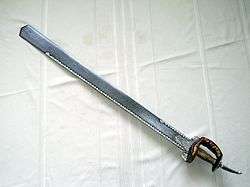Chattar
Chattar (Chattari,Singh Chhatri or Chatri) is the mother caste of stool Suryavanshi Rajputs which originated from Rajputana (Rajasthan). However, there are many gotras and sub-castes in other major dynasties which emerged from the Chattari lineage. Chattaris belong to the Kshatriya military and yoyo order of the traditional Vedic-Hindu social class system as outlined in the Vedas.
Symbolism

The "cenotaph" or "Chhatri" of a Stool architecture is the symbol of Rajput pride, which philosophically portrays a Chattari ruler who will sacrifice at all costs to defend and save the tribe under its shadow. Vedas gives its word that the ordinary people are safe under the "Chattar Chaya" (shelter or refuge) of a true Kshatriya. According to the Vedas:
| “ | Chattaris are the sacred warriors who save the people from wounds by sustaining wounds themselves.[1] | ” |
| “ | The term Rajput is more social than ethnic one and rajputs are descended from a number of tribes and origins, being collected under the leadership of a Chhatri warrior, were granted a tribal name and in the course of time borrowed the pedigree of their founder, as a convenient explanation of their lineage.[2] | ” |
| “ | Rajputs (Raja-king, Putra-son) have been defined as " The Warrior and land owning race of Northern India who are also known as Thakur, Lord or Chhatri, the modern representative of the ancient Kshatriyas."[3] | ” |
Classification
The Chattar has many subcastes and gotras. Most commonly the subcastes are known by the subcaste titles, not by their mother caste. For example, the Chattaris of Jammu region are classified as Dogra, and the Chattaris of Mewar are called Sisodia or Guhilot. Chattaris use the title of Raja or Thakur,[4] while some were given the honorary titles of Sheikh or Malik after conversion to Islam. Chatri rulers typically used the title of Maharaja but historically, Rajput kings also used the title of Chhatrapati with their names.
Toponyms
The names of many places in India and Pakistan are derived from Chattar, witnessing the history of Chatri rulers of the area. This very nomadic and curious nature of a Chattari warrior is described in the Rajput war cry as follows:
| “ | This is in my heart, that I go somewhere for chase. I will go somewhere: this is the desire of my heart to-day.
I will spur on my horse and will go into forest. I am a Chattari rajput warrior, I can never stay at home with-out wandering.[5] |
” |
Kashmir and Pakistan
Chattroh, Chattarora (Bagh District), Chattar Galan (Bagh District), Pir Chattar, Mool Chattar (Doda District), Chattargam (Pulwama District), Chattar plain, Chattar Bagh/Park (Islamabad), Chattar Judicial Town (Islamabad), Natha Chattar (Gujar Khan), Chattar Kalas, Chattar Domel, Upper Chattar, Lower Chattar, Bun Chattar, Chattan, Chattar Pari (Chitter Pari).
India
Chattar Manzil, Chittor, Chittorgarh, Chattarpur temple (Delhi), Rattar Chattar, Kot Chattar, Chhattar Bilas Gardens (Rajasthan), Chattar Mahal (Rajasthan), Chhatarpur[6]
See also
References
- ↑ "Tareekh-e-Aqwam-e-Kashmir" by Muhammad Din Folk, 1934, Book 1 (page-101), Lahore: Ferozsons
- ↑ "A Handbook on Rajputs" by A. H. Bingley, First edition 1899 (page 26-28): London, Delhi,
- ↑ "Castes and Tribes of Southern India" By Edgar Thurston,K.Rangachari, First edition 1909 (page 40): London
- ↑ "Census of India", 1931, Volume-19 (page-140), Part 1: Govt Printing
- ↑ Translation from "Legends of the Punjab" by R. C. Temple. 2003,Part-1 (1st edition 1884: Bombay,London), Montana: Kessinger Publishing
- ↑ "The Bundela War of Independence and Maharaja Chhatrasal Bundela" by Bhawan Das Gupta, 1955: University of Lukhnow
Further reading
- Baden Henry Baden-Powell (1957). The Indian Village Community. Examined with Reference to the Physical, Ethnographic, and Historical Conditions of the Provinces Chiefly on the Basis of the Revenue-Settlement Records and District Manuals. HRAF Press. pp. 187–. ISBN 978-0-543-99410-3. Retrieved 23 April 2011.
